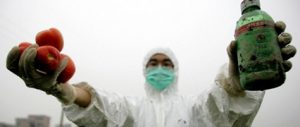From 2009 to 2010, following a decade of scares, China made a concerted attempt to tackle the problem posed to human health by unsafe food. It tried to improve the country’s legislative framework, research capabilities and coordination efforts, passing the Food Safety Law and establishing three new bodies: the State Council Food Safety Commission, the Food Safety Risk Evaluation Expert Committee and the Food Safety Standard Examination Committee. The hope was that these structures would help to stop products carrying toxins or other harmful substances from entering the food chain.
But the problems are still here, and the public is still complaining. New standards for milk and dairy products put together by the Food Safety Standard Examination Committee – a process that took more than a year and reportedly involved intense debate and fraught cross-departmental coordination before it produced a set of 60 rules – were a particular disappointment. Considered even weaker than regulations from the 1980s, they were described in the media as a “historic step backwards”.
This reflects how deep-rooted and difficult to resolve China’s food safety problems are.
Researchers tend to divide China’s food-safety history since 1949 into four stages. During the first, from 1949 to 1979, the country’s biggest challenge was a shortage of staple foods. Over the second stage, the five years from 1979 to 1984, food availability improved but a price of more abundant harvests was widespread use – and overuse – of fertiliser, causing food safety problems “at source”. At the same time, market mechanisms replaced the system of centrally planned food purchasing and sales, while crude and unmonitored food-production workshops accounted for a large proportion of Chinese food processing.
During the third period, from 1984 to 2000, food safety emerged as a formal concept. The state passed the Food Hygiene Law and set standards for the production and regulation of harm-free, green and organic foodstuffs.
The fourth stage covers the years since 2001 to the present, during which a litany of food-safety scares has hit China, and the country has worked to develop a food-safety management system, first with special regulations on food safety from the State Council, and then in 2009 with the passing of the Food Safety Law. The conversation has moved from an emphasis on hygiene to a broader concept of safety. Within just 10 years, the seemingly endless scares have made food safety a deep-set concern for the Chinese public.
From around 2003, food safety scares became more frequent, and were often regional in nature: a particular brand from a particular area would be pinpointed as dangerous. By 2005, China had seen scandals over foods including hotpot broth, rice, pickles, chives and noodles. Illegal additives and the risks in the processing industry became the focus of concerns. Consumers became fixated with certain types of food.
The public and government blamed China’s crude set of food standards. But soon, broader questions were being asked. The panic over cancer-causing food dye Sudan Red was characteristic. The crisis of confidence was no longer regional, partial and confined to certain foods. It became widespread, common and covered many different products.
The 2008 melamine milk scandal, in which at least six babies died and a further 860 were hospitalised after drinking powdered milk laced with the chemical, was another turning point. In the crisis that followed, risks were identified at all the major firms in the powdered milk business. The reputation of a whole food category was destroyed overnight.
When the story came out in 2010 that Chinese people were consuming three million tonnes of illegally recycled cooking oil every year, fatigue set in. In fact, people have long known about this underground industry, but the complex web of interests behind it has made the “gutter oil” problem impossible to eradicate.
Over the past 10 years, the challenge posed to the food sector by China’s industrialisation has become clear, and society has paid a high price.
The food supply chain is long and complex, stretching from primary crops in the field to processed products, from agriculture to industry. Many people consume basic foodstuffs produced by small businesses in a barely regulated sector. Various authorities fire out orders, while conflicting standards paralyse enforcement efforts and businesses seem like they’re competing to reach new ethical lows. It’s an industry that operates more on tacit understandings than rigorous controls. “Scientific research” serves to increase output and appearances. Unregulated markets are chaotic, waste is widespread and anything goes as long as it cuts costs.
Safety is always an issue when food industries modernise, and not just in China. Historically, western nations had similar experiences – and they still see problems today. Foodborne illnesses have been documented on every continent over the last decade, according to the World Health Organisation.
Food safety problems the world over share common roots: the profit motive, an imbalance of information between producer and consumer, inadequate laws and rules and weak regulation. But different nations approach these problems in different ways, through legislation, judicial practice, governance and social response. China’s most notable characteristic here is that it lacks a mature and modern consumer movement, and consumers as a group are relatively unsavvy about making choices and getting their voices heard. Lu Fang of Jilin University’s philosophy institute believes this is a key reason for China’s worsening food safety problem.
Over the years, China has seen the same sequence repeat itself time and again: exposure, outrage, falling sales, fear and government intervention. By 2008, whenever doubts were raised about any particular product, the farmers growing that food would suffer severe losses. And production would be further concentrated in the hands of large-scale industrial farmers.
As food-safety problems have worsened over the decade, many experts have argued that elements of the public’s attitude to food safety are misguided – such as zero-tolerance for risk, exaggerated fears about chemical pollution and a tendency to conflate fake brands and unsafe foods. Behind this expert view is the assumption that food production should be regarded not as part of the agricultural chain but as a modern industry.
Chief expert of the Food Safety Risk Evaluation Committee Chen Junshi has repeatedly stated that “good food is made by production, not regulation”.
“Two-hundred million scattered farmers are raising all of China’s chicken, ducks and fish,” he said. “If that doesn’t change, pollution at the source cannot be dealt with. Also, most of China’s half a million food producers are small and medium sized firms – and if you want to ensure that levels of microbes meet standards, or that additives are not overused, you need to improve the standards of those workers.”
Behind his words is the assumption that only further industrialisation of the food supply chain will solve China’s food-safety crisis.
But people are already showing themselves nostalgic for the sustainable wisdom of traditional agriculture, with movements pushing for a return to an earlier food culture. Meanwhile, environmentalists are turning their attention to the ethics of livestock farming in light of health dangers posed by meat production.
In late 2009, the US documentary Food, Inc. became popular online in China. Facing their own food safety challenges, Chinese people joined the voices in the west questioning a food industry dominated by market logic.
As well as questions of market regulation, administration and legislation, we need to consider the industrialisation of food production. Chen Junshi has said that everybody would like chemical-free, clean food produced locally on a small scale, but asks if that will be possible given the size of our population. This is the burning question.
Almost all nations where the food industry has completely modernised have community-supported agriculture (CSA) movements, where consumers and producers are in direct contact and rebuild supply chains on a basis of trust. CSA is a civil-society attempt to create new channels to take food from farms to people. Needless to say, working in the shadow of the enormous food industry, these small-scale efforts have only a limited impact. But the Chinese people, embattled by frequent food safety scares, particularly the 2008 melamine milk scandal, are more desperate than ever to shake up the system. This is what the media calls the “battle for the dinner table”.
Xu Nan is managing editor in chinadialogue’s Beijing office
This article is published as part of the project EU-China Civil Society Dialogue, and is a collaboration between chinadialogue and the Institute for Civil Society at Sun Yat-sen University, funded by EU and British Embassy Beijing.
Homepage image by Greenpeace






